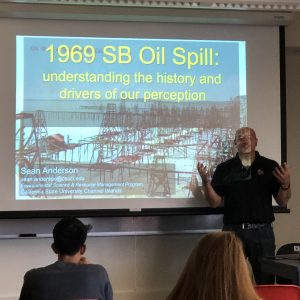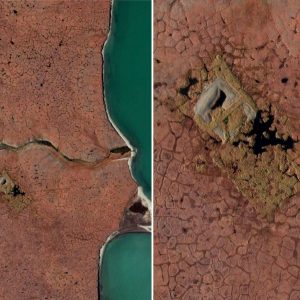To some, the impact of the 1969 Santa Barbara Oil Spill was environmental. To be sure there was ecological harm all around (see any of my old lectures if you are curious about that). But the bigger impacts were upon the burgeoning Environmental Movement, igniting of a generation of environmental activism, birthing a new paradigm/cultural narrative about industry and the natural world, and a massive suite of new policies–from large and federal to small and organizational. Much of these smaller or harder to see consequences of the spill have been difficult for those outside of particular organizations or local Santa Barbara politics to understand. Into this setting comes the newest Pacific Standard piece by Kate Wheeling and Max Ufberg. It does an absolutely FANTASTIC job of recollecting the 1969 Santa Barbara Oil Spill and its aftermath, told in the words of the players themselves.
By way of full disclosure, much of this story is deeply intertwined with my own personal journey. Among other ties, I am a graduate of the Environmental Studies Program at UCSB which (as described in this piece) was a key outcome of the 1969 spill. Many of the folks interviewed in this story (especially Rod Nash) have been key mentors of mine and helped mold my thinking on oil spills and the environment, sparked new career paths for me, provided templates for my scholarship and teaching, and generally had a disproportionate impact on my life and as an engaged citizen and professional scientist. Such long-lasting impacts are but one measure of the impact of this spill continues to exert upon so many of us.
Normally when it comes to sharing a news story, I simply post the piece to one of my Scoop.It feeds (like Coastal Restoration or Intro to RPS) or tweet it out , but this story is so good and so complete, I’m posting the piece directly here in my blog with minimal context. You simply need to read this great piece. This is a prime example of why we all need to support long-form journalism.
So without further ado, here is the link to this great piece:

‘The Ocean Is Boiling’: The Complete Oral History of the 1969 Santa Barbara Oil Spill
On January 28th, 1969, crude oil and gas erupted from a platform off the coast of Santa Barbara, California. Alarm over the disaster reverberated around the world, energizing the nascent environmental movement and leading to a slew of legislative changes.
On the morning of January 29th, 1969, Santa Barbara News-Press reporter Bob Sollen received a call from an anonymous source. When he answered, the voice at the other end of the line rang out clear and urgent: “The ocean is boiling.”
For nearly 24 hours, gas and thick black oil had been bubbling to the water’s surface, and, with each lapping wave, the sludge inched closer to the California coastline. The day before, the workers on an offshore oil rig called Platform A were removing the drill pipe from a freshly bored well when gas and drilling mud erupted onto the platform. Though the crew managed to stopper the top of the well, the highly pressurized gas and oil continued leaking into the water through faults and fractures in the upper layer of the ocean floor.
Platform A was owned and operated by Union Oil, a petroleum company headquartered in nearby El Segundo, California. With no contingency plan and no federal regulations in place, it took Union months to contain the blowout. In all, three million gallons of crude oil spilled out into the Pacific, unfurling across more than 800 square miles of ocean, coating 35 miles of beach, and killing more than 3,600 seabirds and countless marine mammals and fish in the process.
Santa Barbarans of all ages mobilized against the profound degradation of their otherwise-pristine seaside city, long known as “The American Riviera.” Demonstrations took many forms: There were the dozens of local protests against Union, which saw residents lashing out at ecological injustice; there were grassroots factions like Get Oil Out!, which distributed pamphlets and bumper stickers and once famously dumped a bucket of oil onto the desk of a Union Oil executive; and there was the lawsuit against Union, filed jointly by the city, county, and state.
The blowout — then the largest in United States history — drew global attention, too, as images of oil-coated marine life circulated in news reports around the world. That reporting got people thinking about how to balance their desires for economic progress (and cheap energy) with the emerging idea that humans have a moral obligation to protect the environment.
The spill was followed by decades of bipartisan environmental action: Members of Congress worked across the aisle to create the first Earth Day in April of 1970 as well as several key acts of environmental legislation. For Union Oil, the spill represented a colossal bungle, one exacerbated by its own executives’ apparent callousness. “I am amazed at the publicity for the loss of a few birds,” Union Oil president Fred Hartley infamously said after the spill.
It would be a stretch to say the oil spill precipitated the modern environmental movement. But the disaster certainly called forth a more tactical and coherent national effort, and imbued environmentalism with the kind of fervor that had already galvanized the push for women’s equality, civil rights, and peace in Southeast Asia.
There would be many more spills in the U.S. in subsequent years, but never again would industry and government officials be so ill-prepared. All that protest, and all that legislative change, thanks in large part to the fuss over “the loss of a few birds.”…





Leave a Reply